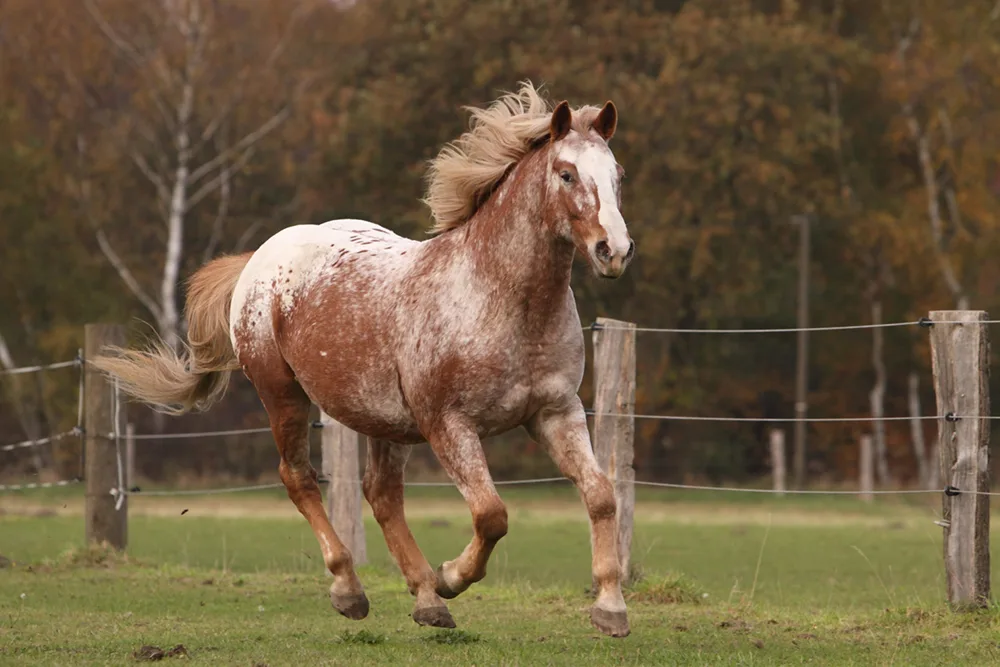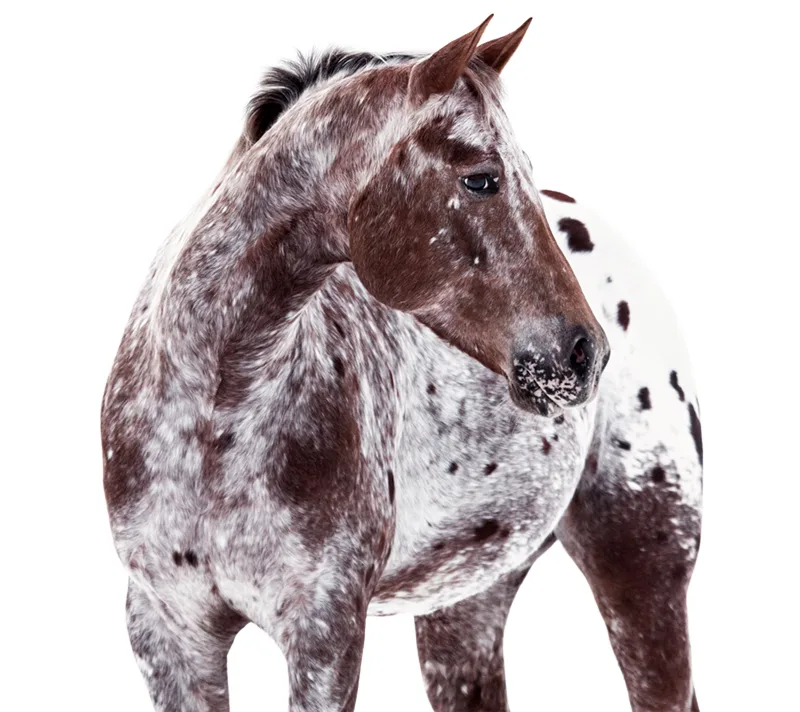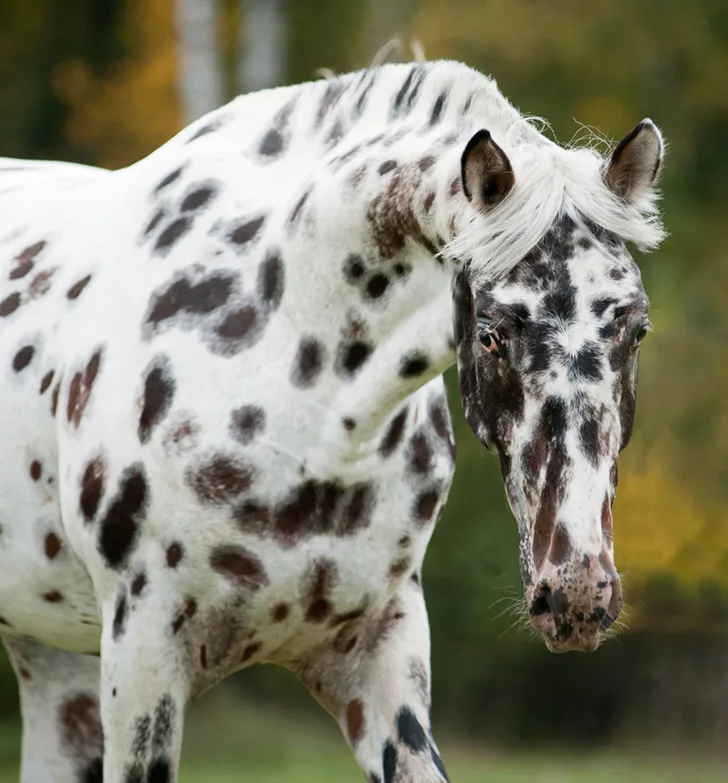The HQ Team were blown away by the exquisite Appaloosas on display at Horse of the Year 2025. Here we give you the low down on this unique and versatile breed.
History
The Appaloosa is a breed with a storied past, tracing its roots to the Nez Perce people of North America. The Nez Perce people selectively developed the Appaloosa for its endurance, agility, and striking coat patterns. The breed’s name originates from the Palouse River region, where the Nez Perce lived and bred their horses. Unfortunately, the Appaloosa population was nearly wiped out during the late 19th century due to conflicts between the US government and the Nez Perce. However, dedicated breeders in the 20th century revived and formalised the breed, ensuring its survival and continued popularity.

Evolution of the breed
The original ‘old type’ Appaloosa was a tall, narrow-bodied, rangy horse. The body style reflected a mix that started with the traditional Spanish horses already common on the plains of America before 1700. Then, 18th-century European bloodlines were added, particularly those of the ‘pied’ horses popular in that period and shipped en masse to the Americas once the colour had become unfashionable in Europe. These horses were similar to a tall, slim Thoroughbred-Andalusian type of horse.
The ‘old type’ Appaloosa was later modified by the addition of Draft Horse blood after the 1877 defeat of the Nez Perce, when US Government policy forced the Native Americans to become farmers and provided them with Draft Horse mares to breed to existing stallions.
After the Appaloosa Horse Club was formed in 1938, a more modern type of horse was developed using American Quarter Horse and Arabian bloodlines. The addition of Quarter Horse lines produced Appaloosas that performed better in sprint racing and halter competitions. Many cutting and reining horses resulted from old-type Appaloosas crossed on Arabian bloodlines, particularly via the Appaloosa foundation stallion Red Eagle. An infusion of Thoroughbred blood was added during the 1970s to produce horses that were even more suited for racing. Many current breeders also attempt to breed away from the sparse mane and tails; therefore, modern Appaloosas have fuller manes and tails.

Distinctive markings and coat patterns
The coat colour of an Appaloosa is a combination of a base colour with an overlaid spotting pattern, and it is this unique group of spotting patterns, collectively called the ‘leopard complex’, that most people associate with the breed. The base colours recognised by the Appaloosa Horse Club include bay, black, chestnut, palomino, buckskin, cremello or perlino, roan, grey, dun and grulla. Appaloosa markings have several pattern variations.
Predicting a grown Appaloosa’s colour at birth is not always easy. Foals of any breed tend to be born with coats that darken when they shed their baby hair, and to complicate matters further, Appaloosa foals do not always show classic leopard complex characteristics. Patterns sometimes change over the course of the horse’s life although some, such as the blanket and leopard patterns, tend to be stable. Horses with the varnish roan and snowflake patterns are especially prone to show very little colour pattern at birth, developing more visible spotting as they age.
The Appaloosa Horse Club also recognises the concept of a ‘solid’ horse, which has a base colour, “but no contrasting colour in the form of an Appaloosa coat pattern”. Solid horses can be registered if they have mottled skin, and one other leopard complex characteristic.
NOTE
Solid Appaloosa horses are not to be confused with grey horses, which display a similar mottling called ‘fleabitten grey’. As they age, ‘fleabitten greys’ may develop pigmented speckles in addition to a white coat. However, ‘fleabitten gray’ is related to a different gene, and is unrelated to the leopard complex gene seen in the Appaloosa breed. Similarly, ‘dapple grey’ horses are also different from Appaloosa horses, in terms of coat colour genes and patterning.
Base colours are overlain by various spotting patterns, which are variable and often do not fit neatly into a specific category. These patterns are described as follows:
Spots: A horse that has white or dark spots over all or a portion of his body.
Blanket or snowcap: A solid white area normally over, but not limited to, the hip area with a contrasting base colour.
Blanket with spots: A white blanket which has dark spots within the white. The spots are usually the same colour as the horse’s base colour.
Leopard: A white horse with dark spots that flow out over the entire body. This is considered an extension of the blanket to cover the whole body.
Few spot leopard: A mostly white horse with a bit of colour remaining around the flank, neck and head.
Snowflake: A horse with white spots and flecks on a dark body. Typically, the white spots increase in number and size as the horse ages.
Appaloosa roan, marble or varnish roan: A distinct version of the leopard complex. Intermixed dark and light hairs with lighter coloured areas on the forehead, jowls and frontal bones of the face, over the back, loin and hips. Darker areas may appear along the edges of the frontal bones of the face, and on the legs, stifle, above the eye, point of the hip and behind the elbow. The dark points over bony areas are called ‘varnish marks’, distinguishing this pattern from a traditional roan.
Mottled: A fewspot leopard that is completely white with only mottled skin showing.
Roan blanket or frost: Horses with roaning over the croup and hips. This blanket normally occurs over, but is not limited to, the hip area.
Roan blanket with spots: A horse with a roan blanket that has white and/or dark spots within the roan area.

Colour genetics
As one might expect, scientists are fascinated by Apploosa patterning and the genetics involved in creating it.
Any horse that shows Appaloosa core characteristics of coat pattern, mottled skin, striped hooves, and a visible white sclera, carries at least one allele of the dominant ‘leopard complex’ (LP) gene. The use of the word ‘complex’ is used to refer to the large group of visible patterns that may occur when LP is present.
Not every Appaloosa exhibits visible coat spotting, but even apparently solid-coloured horses that carry at least one dominant LP allele will exhibit core characteristics such as vertically striped hooves, white sclera of the eye, and mottled skin around the eyes, lips, and genitalia.

Registration requirements
The Appaloosa is “a breed defined by Appaloosa Horse Club bloodline requirements and preferred characteristics, including coat pattern”. In other words, the Appaloosa is a distinct breed from limited bloodlines with distinct physical traits and a desired colour, referred to as a ‘colour preference’. However, Appaloosas are not strictly a ‘colour breed’.
All ApHC-registered Appaloosas must be the offspring of two registered Appaloosa parents or a registered Appaloosa and a horse from an approved breed registry, which includes Arabian horses, Quarter Horses, and Thoroughbreds. In all cases, one parent must always be a regular registered Appaloosa.
The only exception to the bloodline requirements is for Appaloosa-coloured geldings or spayed mares with unknown pedigrees; owners may apply for ‘hardship registration’ for these non-breeding horses.
The ApHC does not accept horses with Draft, Pony, Pinto, or Paint breeding, and requires mature Appaloosas to stand, unshod, at least 14 hands (142cm).
If a horse has excessive white markings not associated with the Appaloosa pattern (such as those characteristic of a Pinto), it cannot be registered unless DNA testing verifies that both parents have ApHC registration.
The other characteristics used to determine if a horse receives ‘regular’ registration are striped hooves, white sclera visible when the eye is in a normal position, and mottled (spotted) skin around the eyes, lips, and genitalia. As the Appaloosa is one of the few horse breeds to exhibit skin mottling, this characteristic “…is a very basic and decisive indication of an Appaloosa.”
Appaloosas born with visible coat pattern, or mottled skin and at least one other characteristic (white sclera or striped hooves), are registered with ‘regular’ papers and have full show and breeding privileges. A horse that meets bloodline requirements but is born without the recognised colour pattern and characteristics can still be registered with the ApHC as a ‘non-characteristic’ Appaloosa. These solid-coloured, ‘non-characteristic’ Appaloosas may not be shown at ApHC events unless the owner verifies the parentage through DNA testing.
Outside of the coat patterns, the Appaloosa Horse Club (ApHC) breed standard also focuses on:
- Height and build: Ranging from 14 to 16 hands, Appaloosas have a balanced, athletic frame.
- Conformation: Well-muscled with strong legs, sloping shoulders, and a deep chest.
- Temperament: Intelligent, willing, and versatile, making them suitable for various disciplines.
- Gait and movement: Smooth and efficient, excelling in endurance, trail riding, and performance sports.
Did you know?
The modern Appaloosa breed maintains bloodlines tracing to the foundation bloodstock of the breed registry. However, it remains a partially open Stud Book allowing the addition of some Thoroughbred, American Quarter Horse and Arabian blood.

The Appaloosa Horse Club (ApHC)
Located in Idaho, the ApHC is the principal body for the promotion and preservation of the Appaloosa breed and is an international organisation. Affiliate Appaloosa organisations exist in South Africa, as well as many South American and European countries, Australia, New Zealand, Canada, Mexico and Israel.
The Appaloosa in South Africa
The Appaloosa has found a niche in South Africa, where it is valued for its hardiness and versatility. The breed is well-suited to local equestrian activities. The South African Appaloosa Horse Club (SAAHC) promotes and registers the breed, ensuring adherence to international breed standards. With dedicated breeders and enthusiasts, the Appaloosa continues to grow in popularity within the South African equestrian community.

